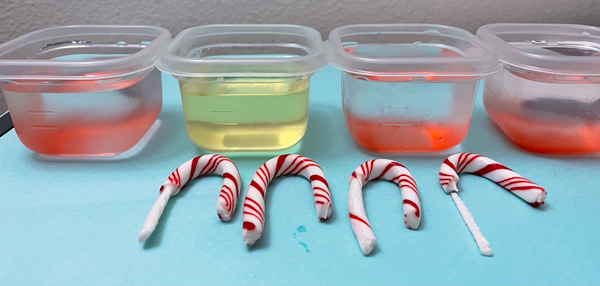Graduate Students Conduct Sweet STEM Outreach Effort

March 8, 2021 - What do Kit Kats, Starburst chews, candy canes and chocolate have to do with science and engineering? It turns out these sweets are all excellent materials to use in experiments that teach children about the scientific method and stimulate interest in STEM. UC Irvine students from the Materials Science and Engineering Graduate Student Association (MSE GSA), led by Sierra Gross, outreach chair and second-year graduate student, have incorporated these candies into virtual workshops they’ve held all year as part of their science outreach to children.
The Anteater Science Workshops are open to families with children of all ages and have attracted around two dozen households per workshop, with students ranging from 3 to 15 years old. MSE GSA targets local school districts, but since the activities are virtual, it has served participants from locations farther afield, including Hawaii.
With “Kit Kats and Plastic Bags,” the graduate students taught participants about the mechanical properties of plastics. With two types of chocolate and a microwave, the UCI students helped children learn about hydrophobicity and phase transitions, and in “Disappearing Candy Canes,” they explained the thermodynamics of mixing, energy and which solvents dissolve candy faster than others. For an upcoming March workshop, they will use Starbursts to illustrate different types of rocks, the rock cycle and the connection to materials processing with structure, property and performance (materials science tetrahedron). Other workshop topics included cakes in a cup, Halloween slime and lava lamp in a cup, among others.
Starting with the same basic format for each workshop, graduate student leaders explain the scientific method, introduce vocabulary for that session, conduct experiments with participating children in breakout rooms, and then regroup for discussion, observations and other science talk. “We use a combination of presenting the material, break out rooms for the experiments and polls to gauge student understanding and engagement,” explained Gross. “Overall, it has been a great experience hearing the kids make their predictions and get excited over the results of the experiments, whether their hypotheses were correct or not.”
“Sierra and the rest of the GSA volunteers have managed to succeed in one of the most challenging tasks for even experienced educators: conveying science in an engaging and effective way to an audience of kids from age 3 up to 18,” said Stacy Copp, assistant professor and MSE GSA faculty mentor, who participates in the workshops with her 4-year-old. “And they did it all virtually!”
Gross said they hope to increase participation from underrepresented groups. “I know people from different backgrounds may not have the same access to knowledge, and I think it’s really important to get underrepresented groups interested in science,” she said. “By using the same format each time, it shows kids how they can apply it themselves to different things they see in their everyday life. I love hearing all the kids’ questions and inquiries during the workshops. It’s really what we want, even if their understanding of the science behind the experiment isn’t as deep.”
– Lori Brandt
